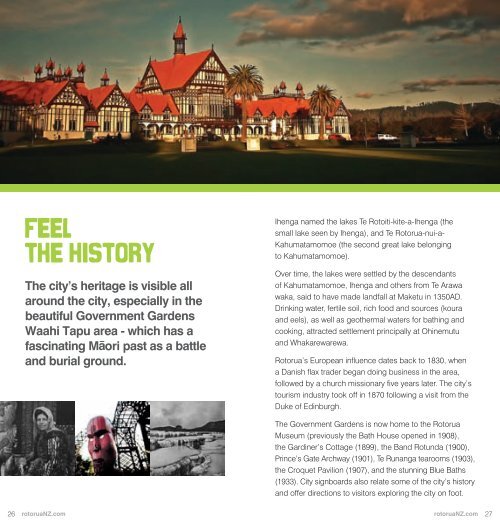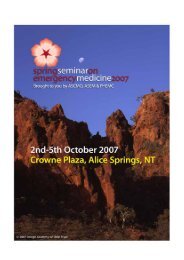Rotorua Motivational Brochure
Rotorua Motivational Brochure
Rotorua Motivational Brochure
Create successful ePaper yourself
Turn your PDF publications into a flip-book with our unique Google optimized e-Paper software.
feelthe historyThe city’s heritage is visible allaround the city, especially in thebeautiful Government GardensWaahi Tapu area - which has afascinating M ori past as a battleand burial ground.Ihenga named the lakes Te Rotoiti-kite-a-Ihenga (thesmall lake seen by Ihenga), and Te <strong>Rotorua</strong>-nui-a-Kahumatamomoe (the second great lake belongingto Kahumatamomoe).Over time, the lakes were settled by the descendantsof Kahumatamomoe, Ihenga and others from Te Arawawaka, said to have made landfall at Maketu in 1350AD.Drinking water, fertile soil, rich food and sources (kouraand eels), as well as geothermal waters for bathing andcooking, attracted settlement principally at Ohinemutuand Whakarewarewa.<strong>Rotorua</strong>’s European influence dates back to 1830, whena Danish flax trader began doing business in the area,followed by a church missionary five years later. The city’stourism industry took off in 1870 following a visit from theDuke of Edinburgh.The Government Gardens is now home to the <strong>Rotorua</strong>Museum (previously the Bath House opened in 1908),the Gardiner’s Cottage (1899), the Band Rotunda (1900),Prince’s Gate Archway (1901), Te Runanga tearooms (1903),the Croquet Pavilion (1907), and the stunning Blue Baths(1933). City signboards also relate some of the city’s historyand offer directions to visitors exploring the city on foot.26 rotoruaNZ.comrotoruaNZ.com 27



